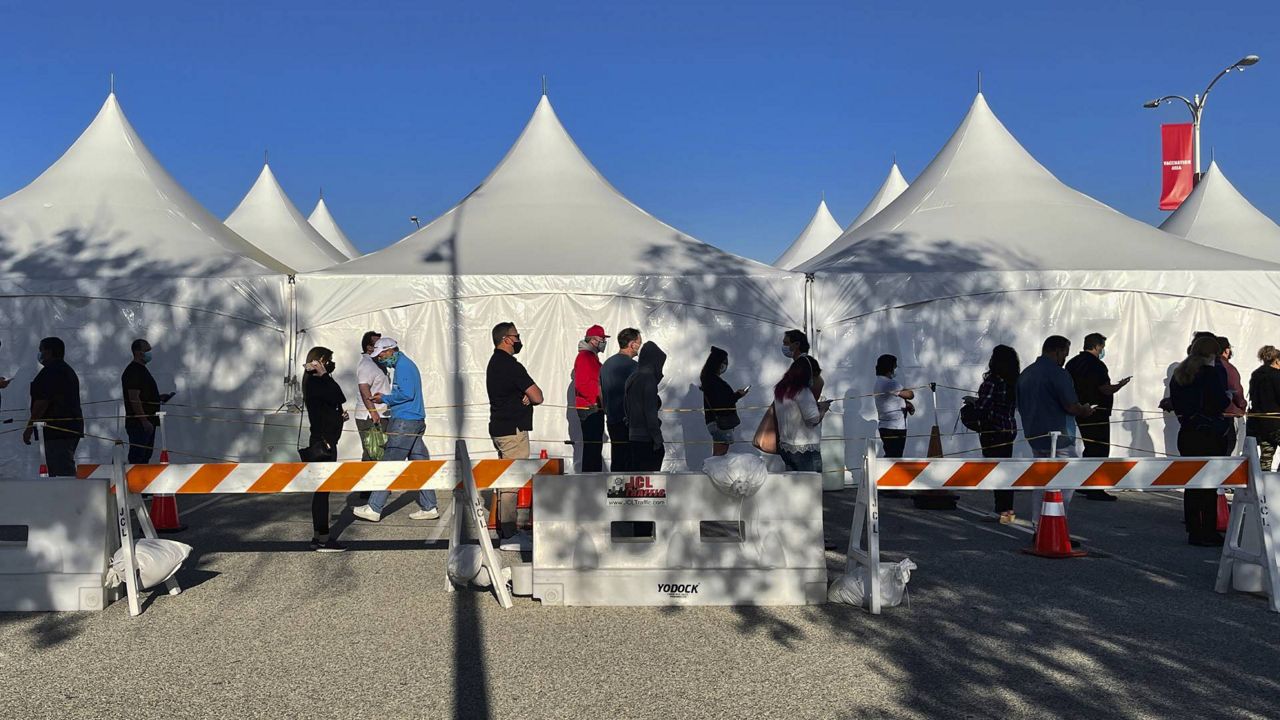LOS ANGELES (CNS) — Los Angeles County's rate of decline in new COVID- 19 cases and hospitalizations slowed dramatically over the last month, but it slowed nonetheless, so far helping avoid the surges in infections being seen in other parts of the country, the county's public health director said Wednesday.
"While all of our metrics are indicating less community transmission, the rate of decrease is slowing for hospitalizations and cases," Barbara Ferrer told reporters in an online briefing.
What You Need To Know
- L.A. County reported 479 new infections and 53 deaths on Wednesday
- There were 572 people hospitalized due to COVID in the county as of Wednesday, up from 552 on Tuesday
- There were 136 people in intensive care, a drop from 138 on Tuesday
- Barbara Ferrer said the increasing number of variants and the slowing decline in new cases and hospitalizations should serve as a warning for residents
According to Ferrer, the average number of daily new COVID-19 infections dropped by 82% during the month of February. In March, it dropped by only 42%, and by the end of the March, "our case numbers stopped significantly declining altogether," Ferrer said.
Daily hospitalization numbers showed a similar pattern, dropping by 70% in February, but only by 57% in March.
The only metric to buck the trend was the number of COVID deaths, with the daily average dropping by 63% in February and then 86% in March.
California COVID-19, By The Numbers:
— CA Public Health (@CAPublicHealth) April 7, 2021
🔹 Confirmed cases to date: 3,586,059
🔹 Note: Numbers may not represent true day-over-day change as reporting of test results can be delayed
More information at https://t.co/TLLUGwPGY7. pic.twitter.com/EsLyEVUxFb
Whether the slowing pace of improvements in case numbers and hospitalizations are a cause of concern is yet to be seen. But it played out Tuesday when the state released its updated county-by-county COVID statistics, showing Los Angeles County's average daily rate of new cases holding steady at 3.1 per 100,000 residents, ending a weeks-long downward trend.
Maintaining the 3.1 rate slowed the county's march toward the less-restrictive yellow tier of the state's Blueprint for a Safer Economy. The county advanced to the orange tier last week, allowing for an easing of capacity limits and reopening of more business sectors, but will now be unable to reach the yellow tier for at least three weeks, and likely longer.
"I think with the case rate as low as it is ... and the test positivity rate being under 2%, we've really reduced significantly community transmission," Ferrer said. "I think the question for all of us is, we could reduce it more — and it would be better if we reduced it more. We still have moderate transmission. That's why we're in the orange tier. It would be lovely to get to the yellow tier, which really means we have minimal transmission going on in the community because your case rate has dropped to less than 2 per 100,000 people.
"Yes, I would like to see our case rate drop more. We'll have to continue to work really hard for that to happen because we have a lot of reopenings, we have a lot of travel, a fair amount of gatherings, I think, over the holiday," she said. "And hopefully people have been doing this with all of the safety precautions so that we continue on this road to reducing, continuing to be able to reduce transmission. Obviously, we can get our rate lower. There's no impossibility on this."
Cases rates have been increasing in numerous other states, raising the danger of people traveling outside the area or visitors coming to the Southland and bringing infections with them. Also of growing concern are COVID-19 variants, with Ferrer on Wednesday confirming the county's first case of a variant first detected in South Africa, and three cases of a Brazilian P.1 variant. Both are labeled "variants of concern" by federal health officials due to their ease of spread from person to person.
Given the limited amount of testing the county conducts to identify variants, the discovery of the new strains in such a small testing sample means "it is likely there are additional undetected and undiagnosed cases," Ferrer said.
Ferrer said the increasing number of variants and the slowing decline in new cases and hospitalizations should serve as a warning for residents not to let their guard down, even as more business restrictions are being eased. She said people need to continue practicing infection-control measures, and get vaccinated when they can.
"We're not more than three weeks out from when we moved into the red tier, and we've not seen any increases in our case rates, test positivity rates or hospitalizations," she said. "This is only possible because of our collective commitment to each other. So please continue keeping yourself, your friends and your family safe."
Ferrer announced another 53 COVID-19 deaths on Wednesday, while Long Beach health officials added one and Pasadena reported three, increasing the countywide total since the start of the pandemic to 23,344.
She also reported 479 new infections, while Long Beach announced 28 and Pasadena three, giving the county an overall total from throughout the pandemic of 1,223,205.
According to state figures, there were 572 people hospitalized due to COVID in Los Angeles County as of Wednesday, up from 552 on Tuesday. There were 136 people in intensive care, a drop from 138 on Tuesday.



